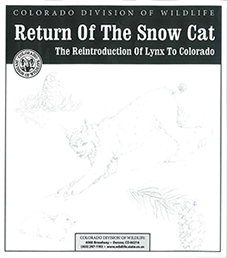
How Do Wolves Impact an Ecosystem provides students with the opportunity to explore the question - How can the presence of wolves in an ecosystem impact other species? Wolves are considered an apex predator in an ecosystem, which can affect other species in that system. In this activity, students explore the wolf’s place in a food web within a Colorado ecosystem to explain their potential impact on the system, including other species.
This one hour lesson is geared towards upper elementary and middle school students giving them the opportunity to explore food webs and trophic levels within an ecosystem and how it may change over time with and without the presence of wolves.
WILD about Black-footed Ferrets invites teachers and students to celebrate the progress of the black-footed ferret recovery program and get involved in the black-footed ferrets’ journey home. Each activity is designed to encourage creative thinking and problem-solving skills. The compelling story of the black-footed ferrets’ comeback demonstrates that dedicated people can work together to create a positive vision of the future.
The activities found in
WILD about Black-footed Ferrets are designed to support national academic standards in Science, Geography, History, and Language Arts for grades 5 through 8. The core lessons will take approximately two weeks (ten 45-minute class sessions) to complete.
WILD about Black-footed Ferrets was developed in 2009 by the
U.S. Fish and Wildlife Service and Colorado Parks and Wildlife.
Prying into Prions: Investigating Chronic Wasting Disease is written for high-school biology and genetics courses. This six-lesson module is designed for approximately two weeks of classroom instruction.
Chronic wasting disease (CWD) is a fatal neurological disease found in deer, elk, and moose. The disease attacks the brains of infected animals, causing them to become emaciated, display abnormal behavior, lose coordination, and eventually—die. Like other transmissible spongiform encephalopathies (TSEs), CWD is a “prion” disease. (Prion is short for “proteinaceous infectious particle”.)
The prion protein exists in two forms. The normal form is found in many types of cells, including those in the central nervous system. The pathological prion form has the same chemical composition, but a different shape! There may be no better illustration of the idea that form dictates function—a central tenet of science and biology.

The Species Question: Applying Taxonomy to Wildlife Research and Management presents a scientific topic - what makes a species unique? - in an engaging and relevant context. Each activity focuses on current endangered species issues and demonstrates that the field of taxonomy, often viewed as a “stagnant” science, is evolving and changing the way we think about and protect species.
Colorado Parks and Wildlife invites high school teachers and students to join in its discoveries, questions, and arguments about species. On the journey, students will develop a clearer understanding of modern taxonomy, the nature of scientific knowledge and the scientific process, the human dimension of science, and the value of peer review.

Return of the Snow Cat: The Reintroduction of Lynx to Colorado
Return of the Snow Cat: the Reintroduction of Lynx to Colorado is an eight-lesson module designed for two weeks of classroom instruction. Real research data from the lynx reintroduction effort in the early 2000's serves as a context to present topics such as ecosystems, population dynamics, and more! The module is designed to supplement or replace the activities found in most high school biology, ecology, or environmental science textbooks that address these topics.
Colorado Parks and Wildlife invites high school teachers and students to join in its discoveries, questions, and arguments about reintroducing species to Colorado. On the journey, students will develop a clearer understanding of wildlife management, develop their critical thinking skills, and apply science to a real-world situation.

